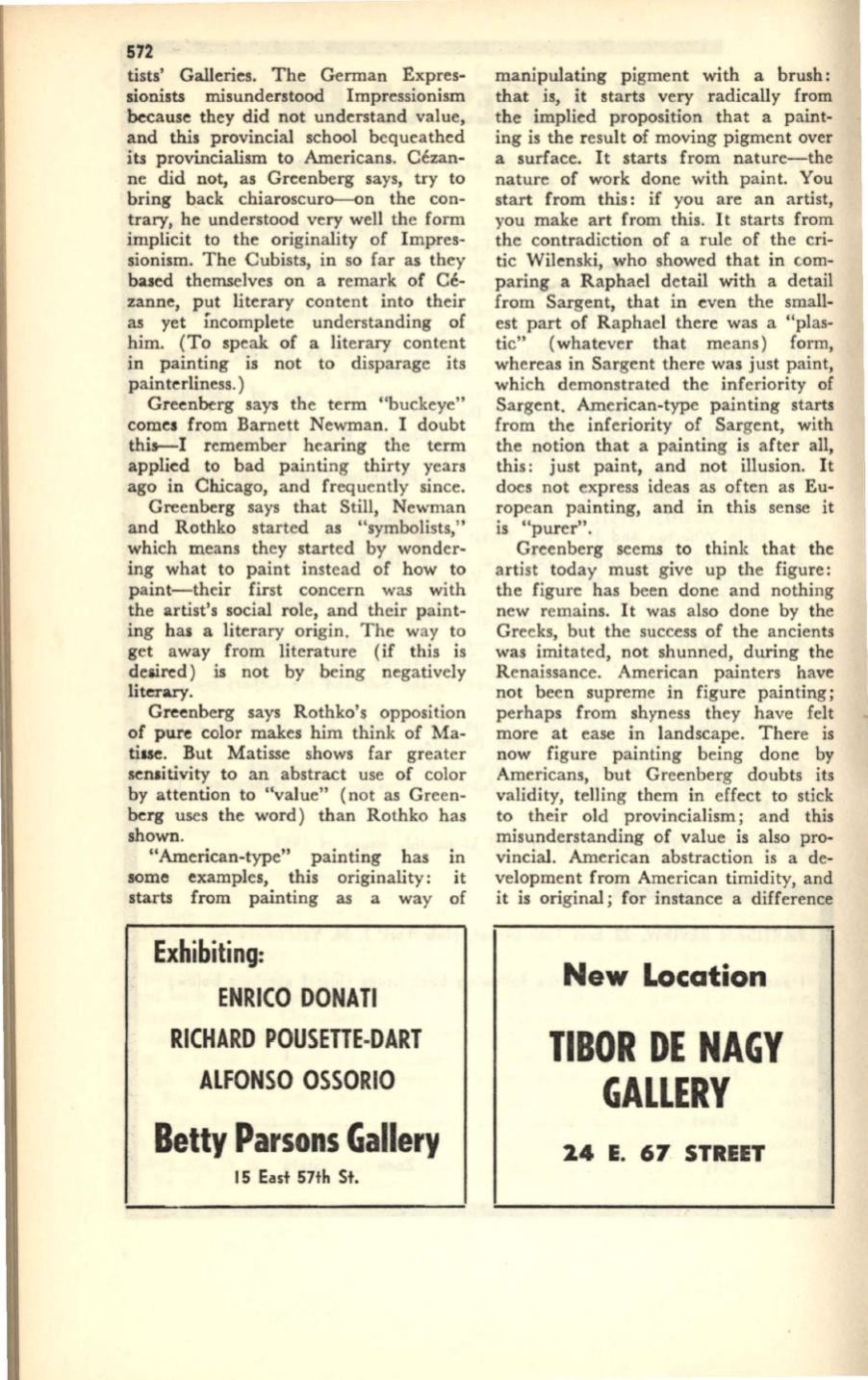
572
tists' Galleries. The German Expres–
sionists misunderstood Impressionism
because they did not understand value,
and this provincial school bequeathed
its provincialism to Americans. Cezan–
ne did not, as Greenberg says, try to
bring back chiaroscuro-on the con–
trary, he understood very well the form
implicit to the originality of Impres–
sionism. The Cubists, in so far as they
based themselves on a remark of Ce–
zanne, put literary content into their
as yet incomplete understanding of
him. (To speak of a literary content
in painting is not to disparage its
painterliness. )
Greenberg says the term "buckeye"
comes from Barnett Newman. I doubt
thi5--I remember hearing the term
applied to bad painting thirty years
ago in Chicago, and frequently since.
Greenberg says that Still, Newman
and Rothko started as "symbolists,"
which means they started by wonder–
ing what to paint instead of how to
paint-their first concern was with
the artist's social role, and their paint–
ing has a literary origin. The way to
get away from literature (if this is
deaired) is not by being negatively
literary.
Greenberg says Rothko's opposItion
of pure color makes him think of Ma–
tiase. But Matisse shows far greater
senlitivity to an abstract use of color
by attention to "value" (not as Green–
berg uses the word) than Rothko has
shown.
"American-type" paIntIng has in
some examples, this originality: it
starts from painting as a way of
Exhibiting:
ENRICO DONATI
RICHARD POUSETTE-DART
ALFONSO aSSaRia
Betty Parsons Gallery
15
East 57th St.
manipulating pigment
with
a brush:
that is, it starts very radically from
the implied proposition that a paint–
ing is the result of moving pigment over
a surface. It starts from nature-the
nature of work done with paint. You
start from this: if you are an artist,
you make art from this. It starts from
the contradiction of a rule of the cri–
tic Wilenski, who showed that in com–
paring a Raphael detail with a detail
from Sargent, that in even the small–
est part of Raphael there was a "plas–
tic" (whatever that means) form,
whereas in Sargent there was just paint,
which demonstrated the inferiority of
Sargent. American-type painting starts
from the inferiority of Sargent, with
the notion that a painting is after all,
this: just paint, and not illusion. It
does not express ideas as often as Eu–
ropean painting, and in this sense it
is "purer".
Greenberg seems to think that the
artist today must give up the figure:
the figure has been done and nothing
new remains. It was also done by the
Greeks, but the success of the ancients
was imitated, not shunned, during the
Renaissance. American painters have
not been supreme in figure painting;
perhaps from shyness they have felt
more at ease in landscape. There is
now figure painting being done by
Americans, but Greenberg doubts its
validity, telling them in effect to stick
to their old provincialism; and this
misunderstanding of value is also pro–
vincial. American abstraction is a de–
velopment from American timidity, and
it is original; for instance a difference
New Location
TIBOR DE NAGY
GALLERY
2.4 E. 67 STREET


